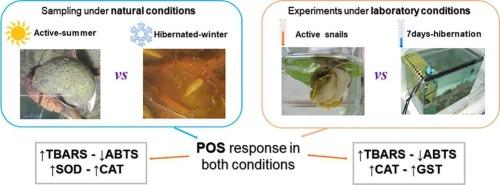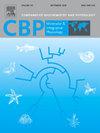Comparison of redox metabolism during hibernation in the apple snail Pomacea canaliculata under natural and laboratory-controlled conditions
IF 2.2
3区 生物学
Q4 BIOCHEMISTRY & MOLECULAR BIOLOGY
Comparative Biochemistry and Physiology A-Molecular & Integrative Physiology
Pub Date : 2025-08-11
DOI:10.1016/j.cbpa.2025.111918
引用次数: 0
Abstract
Preparation for oxidative stress (POS) is an adaptive strategy for tolerating adverse environmental conditions. It has been demonstrated in over one hundred animals, but the vast majority of the work was done under controlled-laboratory conditions and not in nature. There are no studies evaluating this strategy in the same species comparing laboratory and natural conditions. This study aimed to determine whether POS happens in Pomacea canaliculata snails both in the laboratory (controls versus 7-day hibernation) and in animals collected in the wild (summer versus cold-winter hibernation). The activity of antioxidant enzymes, antioxidant capacity (ABTS), lipid peroxidation levels (TBARS), uric acid, and expression of redox-sensitive transcription factors were determined in foot muscle. Hibernating wild-snails presented increased TBARS compared to summer ones, as well as the activities of SOD and catalase and levels of uric acid; ABTS decreased in winter animals. In laboratory conditions, hibernating snails also exhibited increased TBARS, catalase and glutathione S-transferase and a decrease in ABTS levels. Gene expression of Nrf2 increased in laboratory-hibernation whereas HIF-1α decreased in field-hibernation. Our study shows for the first time that the POS phenotype is similar in lab and wild conditions—hibernating snails exhibit higher lipid peroxidation and antioxidant protection in both.

自然和实验室控制条件下苹果蜗牛Pomacea canaliculata冬眠期间氧化还原代谢的比较
氧化应激(POS)的制备是一种适应环境条件的适应性策略。它已经在一百多只动物身上得到了证明,但绝大多数工作是在受控的实验室条件下进行的,而不是在自然界中进行的。目前还没有研究在同一物种中比较实验室和自然条件来评估这种策略。本研究旨在确定在实验室(对照与7天冬眠)和野外(夏季与寒冷冬季冬眠)收集的Pomacea canaliculata蜗牛中是否发生POS。测定足部肌肉中抗氧化酶活性、抗氧化能力(ABTS)、脂质过氧化水平(TBARS)、尿酸和氧化还原敏感转录因子的表达。冬眠野生钉螺TBARS、SOD、过氧化氢酶活性、尿酸水平均高于夏季钉螺;冬季动物ABTS下降。在实验室条件下,冬眠蜗牛也表现出TBARS、过氧化氢酶和谷胱甘肽s -转移酶的增加和ABTS水平的降低。Nrf2基因在室内冬眠时表达升高,而HIF-1α在野外冬眠时表达降低。我们的研究首次表明,POS表型在实验室和野生条件下相似-冬眠蜗牛在两者中都表现出更高的脂质过氧化和抗氧化保护。
本文章由计算机程序翻译,如有差异,请以英文原文为准。
求助全文
约1分钟内获得全文
求助全文
来源期刊
CiteScore
5.00
自引率
4.30%
发文量
155
审稿时长
3 months
期刊介绍:
Part A: Molecular & Integrative Physiology of Comparative Biochemistry and Physiology. This journal covers molecular, cellular, integrative, and ecological physiology. Topics include bioenergetics, circulation, development, excretion, ion regulation, endocrinology, neurobiology, nutrition, respiration, and thermal biology. Study on regulatory mechanisms at any level of organization such as signal transduction and cellular interaction and control of behavior are also published.

 求助内容:
求助内容: 应助结果提醒方式:
应助结果提醒方式:


